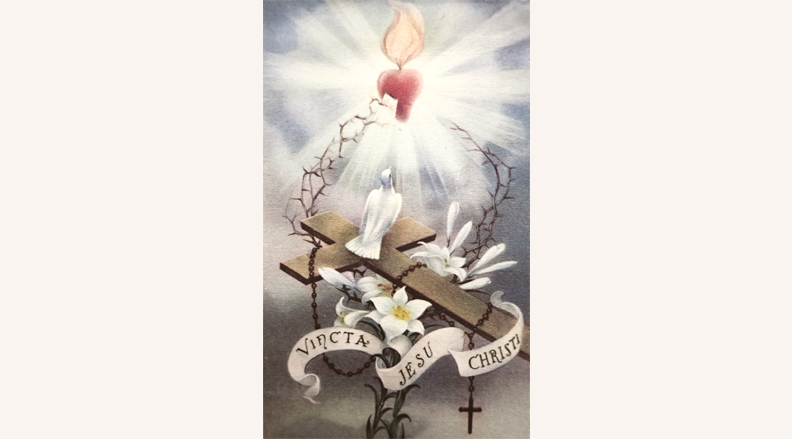
Chastity and Charity
“In the Resurrection they shall neither marry nor be married,
but shall be as the Angels of God in Heaven.”
– Matthew 22:30
Dear Friends of Carmel,
This intriguing remark of Jesus served as a bit of a rebuke to His questioners, as He answered their ignorance of Heaven and our eternal destiny. But as followers of the Savior, we exult in His words that reveal something of eternal life in God. As well, these words have served well to define what is perhaps the most notable trait of the soul consecrated to God in Religious life. Religious life is a sign and testimony in this world of the world to come! St. Augustine says that it is “the portion of the angels.” (De Virgin. xiii)
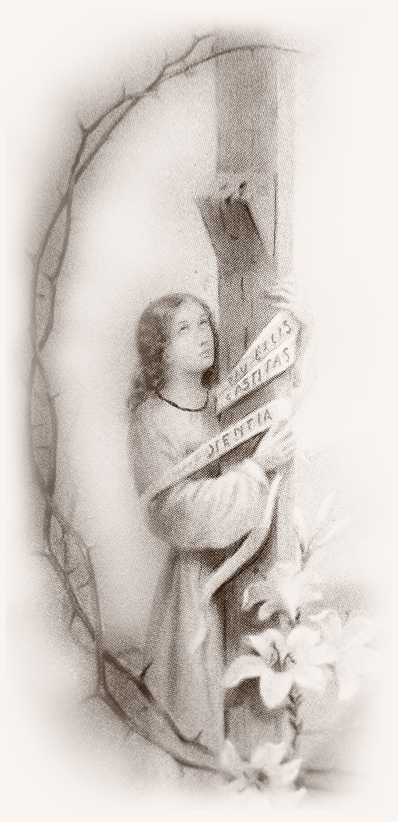
In one of our previous newsletters this year, we spoke about the three vows, poverty in particular – the detachment and virtues it produces in the soul and the need that all Christians have for this virtue, religious and laity alike. In this newsletter, we thought we would take an opportunity to speak about the second evangelical vow, chastity.
It is not without some hesitancy that we bring up the subject of religious chastity, one which is at the center of much controversy in the Church at this time. There is no hiding the fact anymore that celibacy and the vow of chastity have been grossly, ruthlessly abandoned and abused over the past several decades (we talked more about this scandal in our past newsletter Exaltation of the Holy Cross). Many blame the crimes (which in reality are more than criminal, but sacrilege, a fact not often mentioned) on the vow of chastity itself, as if this exquisite, highly and perennially esteemed virtue were the problem. They say holy chastity is an unnatural and all too demanding expectation to ask of priests and religious and is at the root of the problems in the Church. Let us delve into this oft’ misunderstood and despised virtue and holy vow.
Some years ago, we were sorting through books that had been donated to us from a now-closed seminary library. We ran across a book (70s vintage) with retreat conferences given by a Carmelite priest. What a disappointment to read how the retreat master described the vow of chastity as nothing more than “a suppression of an instinct to propagate the species.” We discarded it in no short order, reflecting yet again that not everything that has been put into print is the truth! This sublime vow is hardly that, for heaven’s sake! It is not a “suppression” of anything, but rather an elevation! However, if “suppression” is how some Religious these days view our vow of perpetual chastity, then it seems more than likely, that this total lack of supernatural faith and outlook is at the root of the problem.
But putting aside the vow for a moment, let us first talk about chastity as a virtue. It is not a “new” requirement or virtue by any means. In fact, it goes back to the “basics” – the ten commandments. Nor is it a virtue belonging only to religious. Married/unmarried, Religious or lay, God’s holy law requires His children to live chastely.
“Outside of marriage, absolute continence is demanded of everyone without distinction. Conjugal chastity limits marital pleasure to the ends of marriage itself. Even as poverty frees us from slavery to earthly goods and regulates their use, so chastity frees us from the slavery of our senses and moderates their use. Hence the virtue of chastity is not restricted to those who are consecrated to God, but is a serious obligation for every Christian.”
Father Gabriel, Divine Intimacy

St. Thomas Aquinas speaks of this obligation when he says that virginity/chastity, as a virtue, “is never lost without sin.” The virtue of chastity is in essence the remedy for the concupiscence of the flesh – that is, the rebellion of the flesh against the spirit, consequence of original sin, which we all inherit. The appetite for pleasures of the flesh, which before the fall was subject to reason, became after the fall an unruly desire which often prompts us to take part in forbidden pleasures as well as lawful ones. This “sting of the flesh,” as the Fathers of the Church quoting St. Paul speak of it, bears heavily on every member of the human race. Chastity is the control and regulation of our sensual pleasures in accordance with the laws of God. On a much deeper level, chastity is another one of the evangelical virtues meant to bind us more closely to God, to teach us and bring us to perfect detachment. While poverty (as discussed in our previous newsletter) teaches us detachment and removes any thing between us and God, chastity removes any person. Chastity purifies and elevates our natural human affections (affections which are often unruly and misdirected because of the damage of original sin) directing them to be in God and for His sake. In its highest practice, it is essentially the virtue of charity. Love of neighbor, not for neighbor himself, but because of, and for, and through the love of God. This (supernatural) love of neighbor is much more pure, more encompassing, more compassionate, than our natural affections allow, which, once again because of original sin, tend to cling only to those things that please us. Without chastity, a virtue of the will and mind and heart, our love of neighbor often becomes merely love of self. Without chastity, our love of neighbor remains shallow, superficial, and sometimes, very unwise.
And so now, what is the Vow of Chastity? It is a renouncing of all sensual pleasures, even the legitimate ones, of marriage. All unmarried people are bound to chastity, by God’s holy law. And of course, so are we. However, through the vow we have made, chastity becomes more than just a law to be observed and virtue to be practiced, but a true holocaust and an act of worship. Through this consecration, this sacrifice, a Religious frees his or her heart for God – for God alone. For St. Paul says
I would have you free from care. He who is unmarried is concerned about the things of the Lord, how he may please God. Whereas he who is married is concerned about the things of the world, how he may please his wife; and he is divided. And the unmarried woman, and the virgin, thinks about the things of the Lord, that she may be holy in body and in spirit. Whereas she who is married thinks about the things of the world, how she may please her husband.
(1 Corinthians 7:32-43).
The vow of chastity, then, is the means of bringing one quickly and speedily to the most perfect practice of the virtue. Far from being a renunciation of love, rather it elevates genuine love to the most supernatural and spiritual level. The vow of chastity is so serious, solemn and holy that any sin against the vow is not only a sin against the sixth commandment, but also a sin of sacrilege – violation of something sacred.
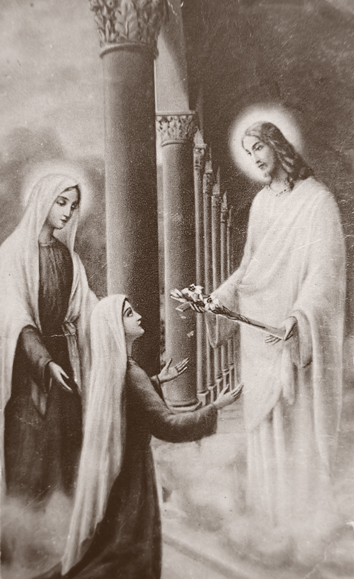
Chastity frees those of us who are called to do the work of God to serve the Lord without impediment. When Religious are consecrated, it is their very person that is consecrated, not just their work and activities. We are Religious “24/7” which demands a true focus of attention and of all of our energy towards God. Raising children and family life, if lived as God intends, is likewise a full time, 24/7 occupation, and demands constant attention and generosity on the part of parents. Religious consecration to God’s work in the priesthood or Religious life cannot be lived together with the weighty commitments of the married state; the two vocations are not compatible in one person. Note well the gravity of the Apostle’s words: “He is divided.”
In Carmel, this freedom, or detachment, from natural human affections is much more extensive than simply the giving up of marriage. The cloister itself, with its grilles and limited communication with the outside world, safeguards us not only from “potential spouses,” but our own family and friends. We no longer take part in the family events, like birthdays, anniversaries, weddings, or even funerals. We are not present in the everyday happenings of those we love, and while we know that what we do here is far more beneficial to our loved ones, it is sometimes very difficult for our families to understand and accept! (And by the way, yes, we do miss being with our families!) But in time, parents, brothers, sisters, and friends come to realize that far from having “lost” us, they have gained our love in a much richer, more perfect way.
Even inside the cloister walls, Our Holy Mother St. Teresa warns – and sometimes quite severely – against the forming of “particular friendships” among the Sisters, friendships with one particular Sister or another, and based upon human likes or dislikes, or shared interests. Such particular friendships divide more than they unite, breaking the Sisters off into groups or pairs. St. Therese in Story of a Soul speaks most eloquently about charity in Community life; truly, her own experience and what she learned is the “standard” for which we strive! In his Precautions, St. John of the Cross says, “You should have an equal love… for all persons…” There is nothing wrong with human friendship. But for the consecrated religious, our friendship with one another must not be a natural one; it must be one rooted in Christ and the love of Christ. We share with all our experiences of the events of our days, our sorrows, joys, and struggles at our daily recreations. In our daily duties, we strive to carry one another’s burdens. Through it all, we are far more united and one in mind than people would ever expect fourteen women to be, living together, day in and day out! We give humble gratitude to God for it.
The white mantle of our holy habit is a reminder of this vow of chastity. Each time we put it on we say the words that were said at our Clothing ceremony. While the mantle is being put over the shoulders of the Sister, the celebrant says, “Those who follow the Lamb shall walk with Him in white, let thy vesture be ever white as a sign of thy inner purity.”
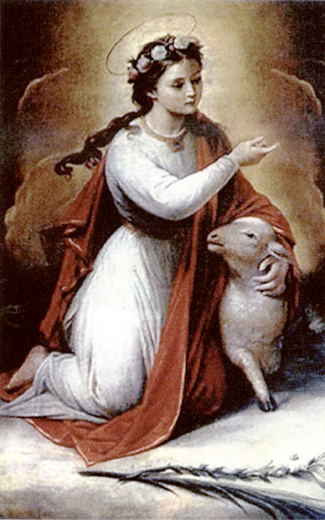
Even more so is the black veil a sign of our religious consecration. In the days of the early Church, virgins did not wear a veil. It was married women who covered their hair, as a sign to all that they already belonged to someone. We belong to Christ and have been consecrated to Him. The color of the veil, black, denotes death, the death to the world and to natural affections that we are expected to practice. Just before a Sister receives the black veil during our veiling ceremony, the words of the great Virgin Martyr, St. Agnes, are chanted by all of the Sisters: “He has placed a sign upon my face, and besides Him I will have no other lover.” Truly, the reception of the veil, with full knowledge of its significance, is one of the greatest joys of a woman religious, who is happy to wear the holy habit and this special sign of God’s possession of her.
One common mistaken notion about Religious life and chastity, presuming naiveté and prudishness, is that women who enter Religious life simply never experienced human love, or never wanted to; or that relationships didn’t work out because of fear. Or perhaps they just couldn’t find the right person to marry. But becoming a consecrated religious does not necessarily mean that one had failed relationships, or had no desire to be married and have a family. One of the Sisters here was even engaged before discovering her religious vocation. No, God is not just “the next best option” if marriage, for whatever reason, doesn’t work out. It is rather the deliberate choice to follow a higher calling, if one has been given that calling by God – a Religious vocation!
Yet another erroneous (and depressing!) notion about Religious life is that it is sterile; an empty life with not much to show for it. Nothing could be further from the truth!
One who embraces the married state becomes a collaborator with God in the transmission of life to others; one who consecrates himself to God by a vow of chastity becomes His collaborator in the transmission of the life of grace to others. The person who is consecrated to God sacrifices material fecundity for a far superior, spiritual fecundity, natural paternity or maternity for supernatural paternity or maternity.
– Divine Intimacy
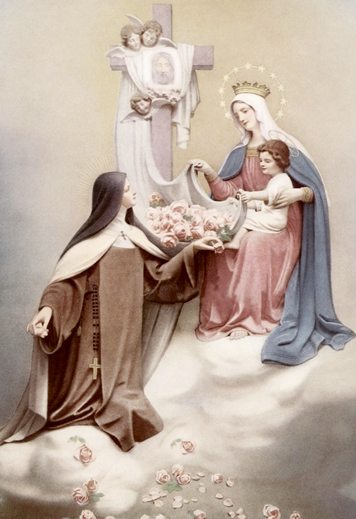
For proof of the fruitfulness of the vow of chastity, one need only consider the Ever-Virgin and Mother, Mary, Queen and model of religious life. Our Lady’s chastity was perfect and immaculate, as was her soul. No heart has ever been consecrated so completely to God as hers. But through this perfect virginity, Our Lady brought forth God Himself, God made flesh. Just as Our Blessed Mother through chastity brought forth the life of Our Lord into the world, so do we through our vow of chastity, participate in bringing forth the life of Our Lord in souls. St. Therese of the Child Jesus described her vocation to Carmel thus: “To be Thy spouse, O my Jesus… and by my union with Thee to be the mother of souls.”
It is plain to see the damage to souls that the violation of this virtue brings about. Sadly, evidence abounds in salvation history and in our own day. We see it first foreshadowed in the sin of Adam, when he chose to “please his wife” rather than to obey God (Gen. 3). King Solomon, through disordered affection and lust gathered to himself many wives, and not wanting to displease his foreign, idolatrous wives, allowed them to build temples to false gods thus encouraging pagan worship into Israel (3 Kings 11). It was because of adultery, and his condemnation of it, that the greatest prophet, St. John the Baptist, was put to death (Matthew 14; Mark 6). England’s Henry VIII desired to take another wife and led an entire Catholic nation into schism – a separation yet unhealed. And what can be said of our own times? The damage to the Church – to its clergy, to children and young people, and the terrible scandal worldwide – is indescribable. And what about the crimes against the unborn in our day? Not even the great pagan civilizations before us actually came to the point of legalizing abortions, a crime which might be said, in many cases, to have roots in the violation of the virtue of chastity. To modern society this heinous crime has become commonplace and a protected “right”. The breakdown of the family, which today wreaks such havoc on the faith and moral stability of Christian civilization, often finds its source in the absence, more, the corruption and destruction of this precious virtue.
But we need not despair! For history also gives us illustrations of the recovery and the marvelous preservation of chastity. For instance, King David, the youth specially chosen by God to shepherd His people, for the very reason of his innocence, humility, fortitude and justice. Yet this fine man fell into sin – adultery with Bethsabee – and then committed murder of the innocent Urias to try to hide it. But upon his repentance at the realization of his crime, God forgave him (2 Kings) and it is believed that he composed as his prayer of deep sorrow before God, the 50th Psalm.
Also, there is St. Mary Magdalene, whose life of impurity made her the notorious “sinner” of the towns Jesus visited during His public life. But transformed by the immense and mysterious grace of the Son of God, she was privileged to hear these words from His lips: “Much has been forgiven her, because she has loved much” (Luke 7). Love then, true, pure and invincible love, broke the bonds of vice that had held her, and turning the great passion in her heart towards God and God alone, nothing held her back from soaring to the heights of perfection: she became one of the greatest mystics the Church has ever known. Lastly, what about St. Augustine, that brilliant, yet conceited, licentious young man whose mother’s tears won from the merciful God his conversion? Heavenly grace helped him in the heroic struggle and eventual triumph over his shameful sins – and produced a Father of the Church, one of the greatest theologians of all time.
In contrast, but still by the powerful grace of the good God, steadfast and immediate was the triumph of St. Maria Goretti. Even to save her own life, she would not submit to the violent advances of her assailant. Six years after her painful death, she appeared to this wretched young man in prison, offering him 14 lilies, one for each of the wounds inflicted upon her, and thereby moving him to conversion and repentance. After serving his 30-year prison sentence, Alessandro Serenelli joined the Capuchins as a lay brother and lived a quiet life of penance and virtue. His attendance at Maria’s canonization is one of those marvels of God’s providential work in souls. Such are the great triumphs of chastity and charity!
Summing up all we have discussed here, chastity, the direction of all of our natural affections to God, first and foremost, is necessary for all. God commands chastity of His children. It is indeed of the natural law to live chastely. It promotes and in many ways constitutes the integrity of a person. But God also means this virtue, as all virtues, to be an important part of the makeup of a Christian civilization – not just the moral and mental health of each person, but contributing to the welfare of society – its health and well being for time and eternity.
The world and the Church need the observance of chastity for all people, religious and laity, single and married. All have a part and a special place, a duty to fill in the Mystical Body of Christ. All of these souls, in Christ, witness in the world to the Gospel and the true Faith. In the married state, people have the special and necessary vocation of raising children for God’s kingdom in heaven and on earth, of preserving the precious institution of the family, the foundation of society. In the Religious state, chastity is elemental to a life dedicated solely to God and His work for souls. Celibacy in the Catholic priesthood and Religious life has become one of its most notable and beautiful hallmarks – and the purity of the Saints is proof of its great fruitfulness.
In closing, having reviewed in a sort of catechetical meditation the virtue and the vow of chastity, we must remark that no one can hide the fact of today’s moral crisis in the Church. The Latin proverb, “Corruptio optimi pessimum est, – the corruption of the best is the worst” comes to mind… This is not the first time in history that the Church has been faced with such a crisis, nor the first time that moral corruption has been found in civilization as a whole. But we stress what must be stressed – what all true, believing Catholics must realize and believe: Rather than “lower the bar,” relax the standard, and declare with a defeatist attitude that perfection in this area of life is something no longer practicable or attainable, let us preach it and live it faithfully. And let us labor with prayer and sacrifice for the restoration of this jewel to its rightful place in the crown of our Holy Mother the Church. Esteem for this virtue is the sign of hope for souls and hope for the world! It may be a difficult and seemingly impossible “turnaround”, but with humility and confidence in God alone, all souls can make the cry of the Psalm, “Create a clean heart for me, O God, and renew in me a steadfast spirit!”
Further reading: Papal encyclicals which give the teaching of the Church, exhorting chastity in the religious state and married state:
Sacra Virginitas
On Holy Virginity
Pope Pius XII – 1954
Haerent Animo
To the Catholic Clergy on Priestly Sanctity
Pope Pius X – 1908
Menti Nostrae
(especially #s 20, 21, 22)
Thoughts for the Clergy of the World
Pope Pius XII – 1950
Ad Catholici Sacerdotii
(especially #s 40-46)
On the Catholic Priesthood
Pope Pius XI – 1935
Sacerdotii Nostri Primordia
(especially #s 20-26)
St. John Vianney
Pope John XXIII – 1959
Casti Connubii
On Christian Marriage
Pope Pius XI – 1930
Website News
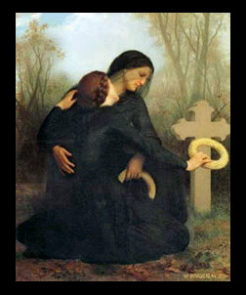
Holy Souls Remembrance
As we do every year, we place our names of our deceased loved ones on our altar during the month of November, to be remembered at all of the Masses here in our chapel. We invite you to enroll the names of your own deceased loved ones before November 1st. Click here to learn more about this practice and send us your names. Click here to learn more about Purgatory and the importance of praying for the dead.
Sacramental Aids to Chastity
We mentioned above that the life of chastity is considered “the life of the angels,” so it will come as no surprise that they are considered the guardians and patrons of this virtue. October is a month especially dedicated to honoring them. October 2nd we celebrated the feast of all our Guardian Angels, at the end of this month (October 24th) is the Feast of St. Raphael. St. Raphael, in addition to being a patron of travelers, in particular is invoked by those wishing to live a chaste life, and by those seeking a good spouse. It was St. Raphael who found young Tobias a good wife, and (after prescribing a period of chastity between the couple and exhorting them to prayer) freed Tobias’ wife from the devil (Tobias 7,8.) Some of the most moving exhortations to chastity in marriage are found in these pages of the Old Testament.
A few years ago, we added the St. Raphael Chaplet to our site that is prayed in his honor and to ask his help, and it has become a popular chaplet. Another beautiful and popular chaplet for those wishing to maintain purity, is the Immaculate Conception chaplet. We recommend this beautiful little chaplet, composed by St. John Berchmans, who recited it every day to obtain, through the intercession of the Virgin Mary, the grace never to commit any sin against the virtue of purity.
Other sacramentals that may be of help to purity are chastity rings (which can be blessed, especially if being worn for this purpose) and St. Benedict medals (blessed with special exorcisms and very powerful against temptations), both of which we have discussed at length in a past newsletter (Chasity rings) and on our Doctrine and Devotions page (St. Benedict medals). We’ve just received from France new styles of St. Benedict medals which make wonderful gifts. Of course, the Angelic Crown is yet another chaplet that honors all the Choirs of Heavenly spirits, our brothers, the Angels, who assist us in living ALL of the virtues of the Christian life.
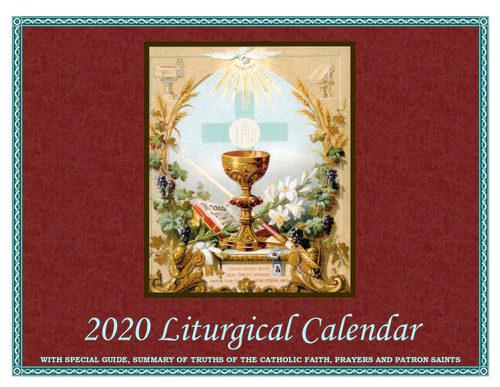
2020 Liturgical Calendar
The 2020 Liturgical Calendar printed by the Seraphim company is now available. It is the ultimate guide to the Feast Days of the Church, and the one we use here at the Monastery.
Spiritual Reading
Since it is October, we wish to call your attention to a few spiritual classics about the Rosary and about our Carmelite saints, St. Teresa of Avila and St. Therese of Lisieux.
The Secret of the Rosary by St. Louis de Montfort is one of his most important writings. He describes the many benefits of the Holy Rosary and how to pray it with true devotion, and as a true child of Mary. No other book has drawn as many souls to the Rosary devotion as this one has, and the love of the Saint for Our Lady, his unction in singing her praises and zeal in leading souls to her is expressed on every page.
Another book inspired by St. Louis de Montfort is To Jesus Through Mary by Fr. Jean-Marie Texier, Montfort Father. This wonderful book gently teaches and clarifies the sometimes misunderstood consecration to True Devotion to the Blessed Virgin Mary. Thoroughly explaining the origin of True Devotion, Fr. Texier gives an account of the Saint’s life, purpose and example. Elucidation of many beautiful doctrines of our holy Faith is woven into his simply and clearly expressed essays. See also the Commentary on the Treatise of True Devotion, a far more detailed, and just as excellent, study of St. Louis de Montfort’s work, by another Montfort Father, Fr. Armand Plessis. Truly, it is through and in Mary that we become pleasing to God!
The writings of our Holy Mother St. Teresa often inspire a bit of fear in souls. But if there is one book that everyone can read with benefit and pleasure, it is The Way of Perfection (Volume 2 of her Complete Works). Although intended as instruction for prayer and spiritual direction for her Sisters living the life of Carmel, this delightful work offers much for those outside Carmel. Her practical advice for daily life, for friendships, for practicing all Christian virtue fills its pages. With gentle humor (and a little acerbic wit!) St. Teresa welcomes and instructs all comers. Be uplifted by this dear and great woman, this Saint!
After “big” Teresa comes “little” Therese. Souls of this caliber always have much to teach us – God has willed it! One book that offers much to present the Little Way of St. Therese is Father Vernon Johnson’s Spiritual Childhood – the Spirituality of St. Therese of Lisieux. Having himself confronted the crisis of conversion through St. Therese’s simplicity and goodness, he found that the only hope for peace in time and eternity is to follow what Our Lord instructed: “Unless you become as a little child…” His book has a solid foundation in careful study of the Saint’s life and writings, as well as intimate contact with the Carmel of Lisieux and Therese’s own sisters and family. A wonderful way to imbibe what St. Therese really meant by “the Little Way” of trust and confidence – is reading this book.
Lastly, following the theme of our letter regarding chastity, we wish to recommend the fine, insightful books of Father Lasance, The Catholic Girl’s Guide and The Young Man’s Guide. Excellent, kindly counsels for the young fill these books – and the virtues of chastity and purity, which Father calls one’s “Most Precious Treasure,” find a place of honor and importance throughout.
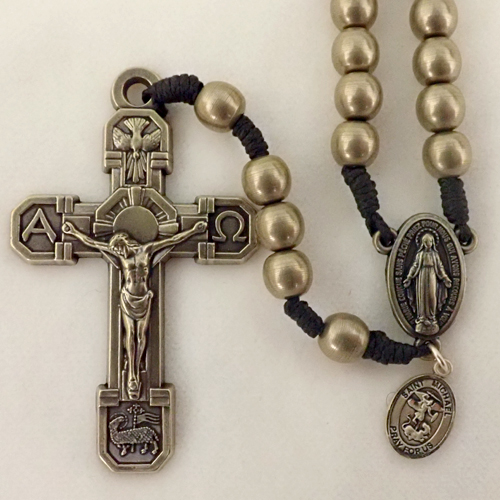
Brass Military Rosary
In honor of October, the month of the Rosary, we have added this handsome brass cord rosary to our rosary selection. This rosary is imported from France, made of hefty brass beads and detailed pieces. A clasp in the back allows it to be worn around the neck.
Community News
There is, in Carmel, never a dull moment, as we have so many times before told you! These past summer months have been for us project after project – repairs mostly, in the original 31-year-old monastery building, as well as in our kitchen, which in 16 years has seen as much activity as any bakery doing business! God’s dear Providence has sent us excellent carpenters and craftsmen, builders and landscapers, and with St. Joseph’s guidance, our stewardship has been blessed.

Since we are coming to the end of the larger, more involved projects, the remaining Sisters in the Community are taking time out for their annual retreats, which started last spring. Every dedicated, hard-working Sister needs and relishes 8 days of silence and solitude alone with God. Time for longer prayer and reflection, more spiritual reading, but also smaller, solitary work projects of sewing and gardening, fill the quieter days for retreatants. We lift up our hearts and allow Our Lord to direct the retreat with His lights and grace – corrections, encouragements, support. And the rest of the Community does not fail to keep each Sister on retreat in their prayers – for the graces so needed to refresh and strengthen us for the coming year of labor for God and for souls.
We are forever sewing, of course. We promised in our July newsletter that we would be working on a simpler, less expensive scapular. In case you haven’t seen it, we now offer it on our website. Without fanfare or announcement, we simply set it up on the site, made a small banner for it on the homepage, and hoped for people to find it (and like it). Time did not permit more until now. But people have found it and do like it. We’ve been sending these scapulars all over the world, along with our embroidered-edge scapulars. Devotion to Our Lady is universal, and we see it in the orders that come to us from – well, just everywhere! The new design presented a few sewing challenges, but we knew the Sewing Sisters would get it right and get accustomed to its quirky differences to make the scapular strong and secure. Remember that the scapulars are washable – and these should last a good long time with daily wear.



We also helped to complete a new vestment for one of our priests in honor of the Immaculate Heart – and in memory of his deceased parents, wonderful people, wonderful Catholics. The vestment is worn most Saturdays, and especially on the First Saturday of each month.
We are gearing up for “vestment ventures” and looking over fabrics, trims, artwork for the embroidery. Part of the preparations must include maintenance of our 16-thread embroidery machine. The Sister who best knows the “innards” of this equipment recently spent several days cleaning it and doing extensive maintenance. Daily maintenance is rather simple, regularly oiling certain gears, brushing out thread dust, etc. A machine that sews out 2000 stitches per minute has many gears and very fast-moving parts that need to be regularly oiled and greased so as not to wear down. All you car mechanics out there will well understand the situation here! Sister had noticed during some recent embroidery work that the presser foot was a little sluggish. Although the small project sewed out fine, she suspected a problem – and problem there was! Carefully opening the thread case at the back of the machine with its screws and bolts of varying sizes, she discerned what looked to her like a brown fuzzy clump of fabric. Um… no… It ended up being positively identified: a petrified, but very greasy, moth! How in the world…? Death by Polymer grease! After Sister’s initial reaction (you can just imagine, perhaps?) the poor critter was easily enough removed, and all is well and spotlessly clean now.

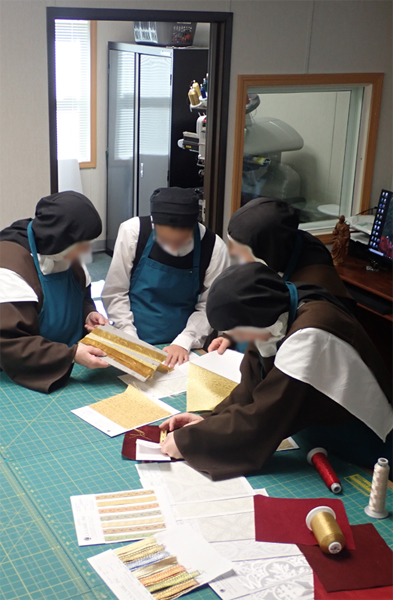

The gardens were, in light of our busier spring – what with the new Loreto building and new website – somewhat neglected this summer. But enough work went into them to produce a wonderful supply of squash, tomatoes, kale, herbs, beans and a few beets, etc. We relocated the garden beds to the north, right near the enclosure wall. Extra wind protection and plenty of sun, it was a good move.
The young aspens planted at Loreto are just starting to turn. In spite of that final, late-May blizzard, all but one of the pines and aspens we added survived and thrived through the summer, Deo gratias. Those trees are symbols, perhaps, of the endurance of Holy Mother Church and of each faithful soul, despite the storms of life and the evils we must confront. Pray for your Mother, Holy Church, pray for priests and all Religious, pray for families and all children. Whatever the vocation, chastity takes a good deal of grace, prayer, perseverance, and dependence on God to preserve…to remain faithful to our vows as baptized Catholics, consecrated Religious, or married couples. Perhaps we could all make our own this beautiful prayer of Pope St. Pius X from his encyclical TO THE CATHOLIC CLERGY ON PRIESTLY SANCTITY:
“May chastity, the choicest ornament of our priesthood, flourish undimmed among you; through the splendor of this virtue, by which the priest is made like the angels, the priest wins greater veneration among the Christian flock, and his ministry yields an even greater harvest of holiness.”

None can entirely avoid the evils of this world, but the protection of God, and of His holy Angels surrounds us at every moment. May we all work in Christ for the one thing that matters, God’s will for each and all: “For this is the will of God, your sanctification” (1Thessalonians 4:3).
You are ever in our prayers,
Your Carmelite Sisters

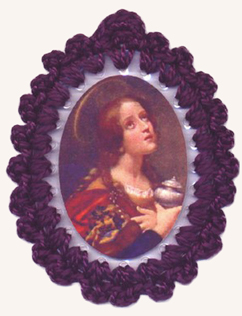


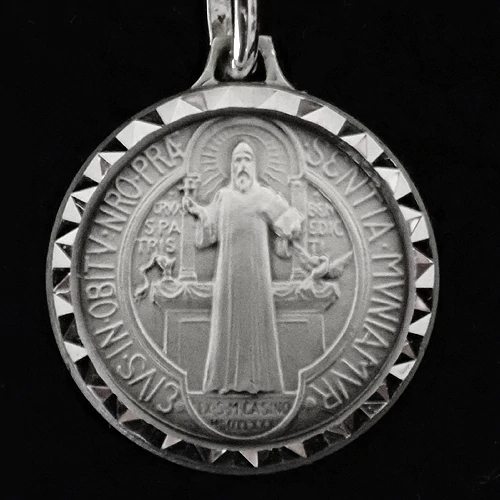
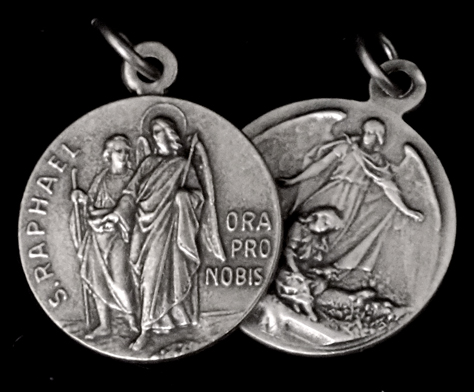
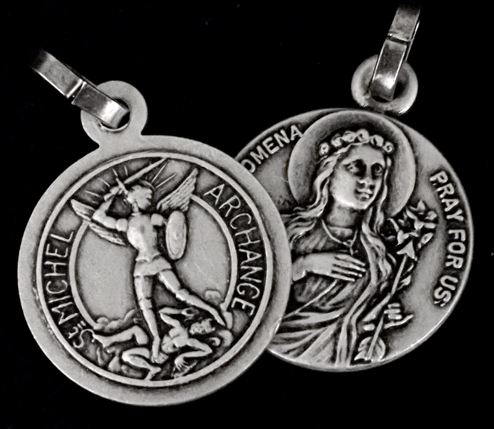
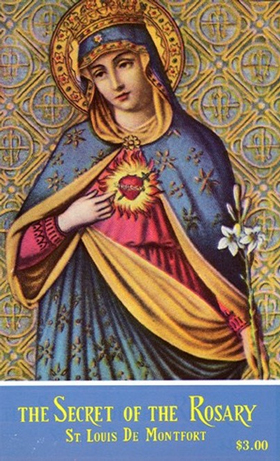
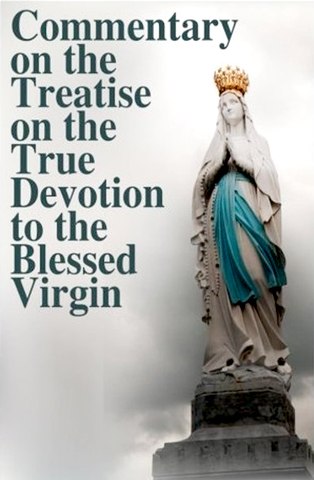

2 thoughts on “Chastity and Charity”
Comments are closed.